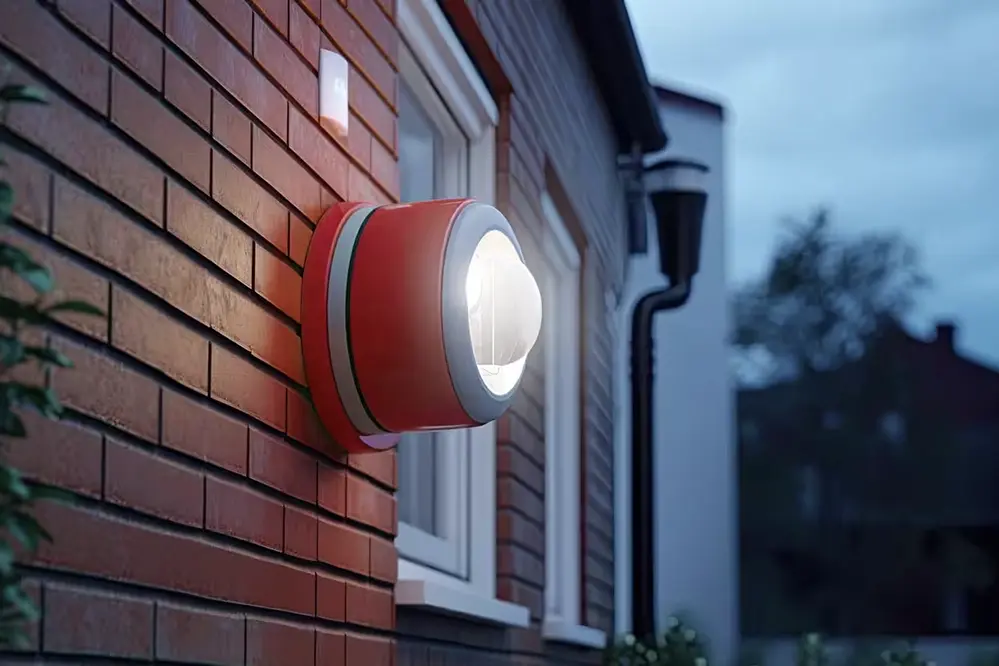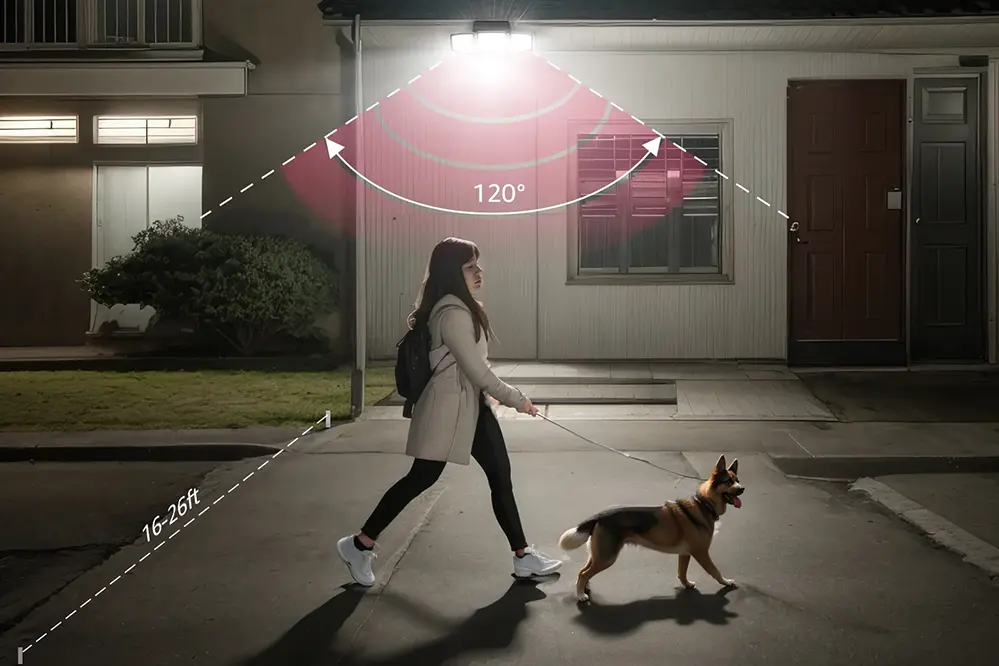Why does my motion detector light stay on all the time? Imagine returning home after a long day, only to find your motion detector light stubbornly illuminating the entire neighborhood. This persistent glow not only disrupts the tranquility of your evening but also raises concerns about energy consumption and security. Motion detector lights are designed to enhance safety and efficiency, yet when they malfunction, they can become a source of frustration.
Understanding why these lights stay on is crucial, as it impacts both your utility bills and home security. Did you know that faulty motion detector lights can increase your energy costs by up to 20%? This statistic underscores the importance of addressing the issue promptly. By exploring the root causes and solutions, you can ensure your lighting system operates as intended, providing peace of mind and cost savings.
Join us as we delve into the common reasons behind this issue and explore practical solutions to restore your motion detector light’s functionality. Whether you’re a homeowner or a tech enthusiast, this guide offers valuable insights to help you tackle this common problem effectively.
Understanding Motion Detector Lights

Motion detector lights, at their core, are marvels of modern technology, designed to enhance security and conserve energy, adding both safety and efficiency to your home environment.
Employing sensors that detect movement, these lights activate only when necessary.
This intelligent mechanism, however, can sometimes encounter issues leading to continuous illumination, which ultimately demands a keen understanding of potential causes and solutions to realign their function.
The possible reasons are wide-ranging; from environmental factors like wind triggering motion to simple configuration settings that need adjustment. By proactively troubleshooting these concerns, one can not only resolve the immediate problem but also harness the full potential of these innovative lighting solutions. This process offers a rewarding blend of technological insight and practical problem-solving prowess.
Common Reasons for Continuous Operation
Inadvertent settings misconfiguration or a faulty switch can result in motion detector lights remaining on indefinitely. Ensuring correct configuration is paramount.
Several external factors, such as wind or foliage, inadvertently set off the sensors, adding to the impression of continuous operation. Thus, regularly trimming nearby vegetation might help.
Sometimes, a power surge or electrical anomaly disrupts your light’s cycle, rendering it “stuck” in the “on” position. A reset might remedy this glitch promptly.
Over time, sensor components can wear out or degrade, resulting in a less responsive and always “on” fixture. Periodic maintenance promises longer, efficient service life.
Ultimately, identifying these issues is your first step. Together, we can achieve optimized security lighting.
Sensor Sensitivity Issues
The sensitivity settings of a motion detector are crucial, as they define its responsiveness to movement. If your light stays on without obvious provocation, it could be indicative of an excessively high sensitivity configuration that reacts to minor disturbances.
Adjusting your motion detector can often solve this “always on” problem. Begin by setting it to a moderate level, observing whether this mitigates the continuous activation. By gradually fine-tuning the sensitivity, you aim to achieve a balance where genuine intrusions are detected, yet mild environmental changes fail to activate the lighting unnecessarily. With these adjustments, your system can better distinguish between harmless motion and actual security concerns.
Adjust Sensitivity Settings
If your motion detector light remains perpetually lit—exuding a constant glow—the sensitivity settings may warrant an adjustment.
Fine-tuning sensitivity can drastically improve energy efficiency, and ultimately, environmental impact and cost savings.
Begin by setting the sensitivity dial to a medium range to test the responsiveness of your system. This approach allows you to observe if the motion detector’s behavior aligns with expected functionality, responding appropriately to actual threats while ignoring insignificant movements.
Evaluate the performance of your lighting system with these new settings, taking note of its reactions over different times of day and environmental conditions. Regularly reassessing and adjusting ensures that your motion detector operates optimally, providing security and peace of mind.
Check for Environmental Triggers
Environmental elements can affect motion detectors.
Factors such as wind, foliage, and nearby traffic can trigger your system. These could be triggering your light sensor unintentionally, resulting in a persistent glow. Furthermore, assessing for reflective surfaces in the sensor’s field of vision can help determine if moving vehicles or swaying trees are causing undue activation.
Observe whether these environmental factors might be the culprit.
Birds and small animals are potential light triggers—if your detector is overly responsive to their movements, recalibrations might be necessary. Consider adjusting the angle of the sensor or trimming branches that fall within its detection range.
Employing strategic solutions can mitigate these triggers and enhance security efficiency. Proactively assessing environmental factors and considering the latest technologies available in the latest years can refine and personalize your security settings. Such approach not only optimizes security but also demonstrates advancement in smart, energy-efficient solutions for sophisticated surveillance systems.
Incorrect Installation Problems
Sometimes, the root cause of a motion detector light staying on lies in improper installation. When motion detectors are mounted inappropriately, they can misinterpret environmental stimuli, leading to continuous illumination.
It is crucial to ensure that the sensor’s alignment and angle are precisely adjusted for optimal performance. Deviations from recommended installation parameters may cause incessant activations, prompting the need for reassessment and realignment.
Properly installed motion detectors not only conserve energy but also bolster overall system reliability.
Ensure Proper Wiring
Proper wiring is fundamental to the reliable operation of your motion detector lights. Even the most sophisticated systems can falter if their wiring isn’t up to standard.
In recent years, advancements have led to highly efficient lighting systems, yet wiring issues remain a potential Achilles’ heel. If the connections are loose or incorrectly installed, it may result in the motion sensor light staying on, reducing both energy efficiency and security.
Thus, it’s of utmost importance to ensure that wiring adheres to the manufacturer’s guidelines. Regular inspections of the connections will aid in maintaining optimal performance and mitigating unwanted constant lighting.
Testing the integrity of your wiring setup, ensuring there is no corrosion or wear, can prevent malfunctions. Tools like voltage testers and continuity testers, widely available today, offer straightforward ways to verify electrical connections without much hassle.
With meticulous attention to wiring, you can avert many common pitfalls and ensure your motion detector lights function seamlessly.
Adjust Motion Detector Angle

Positioning plays a crucial role, ensuring outdoor motion detectors are free from obstructions and able to capture movement as intended.
First and foremost, an improperly angled motion detector may result in continuous activation, keeping the light permanently on. When aiming the sensor, ensure it covers the desired area without overlapping with unnecessary zones of movement such as trees or streets. Transforming setbacks into victories begins with an understanding of the invisible patterns our detectors adopt.
Furthermore, these detectors have a pivotal point of adjustment that needs exploration. If external factors, like wind and small animals, trigger your light, small tweaks can help achieve the balance between effective performance and annoying false activations.
Ultimately, tweaking the angle of your motion detector not only optimizes its utility but maximizes its energy efficiency, too. By orienting it according to the manufacturer’s instructions while keeping in mind environmental interference, you’ll discover that small changes can redefine functionality. This calculated adjustment serves as an empowering step toward a brighter, more efficient space and represents an illuminating triumph in personal home management.
Electrical Interference Concerns
Electrical interference can significantly impact the performance of motion detector lights, causing them to stay on continuously without motion prompts. Identifying these issues is crucial to restoring proper function.
Various electronic devices within the household might emit frequencies similar to those detected by your motion sensor. These include devices like Wi-Fi routers, cordless phones, and even certain lighting fixtures.
Thus, minimizing interference should be your primary focus. To address this, reposition or shield these devices to mitigate their influence on your motion detector.
Additionally, checking your home’s wiring for flaws or faults can alleviate some interference problems. Consider consulting with a professional electrician to ensure a thorough examination of these potential influences.
Beyond merely rectifying a perpetual illumination problem, reducing electrical interference enhances the overall performance and longevity of your motion detector light. It’s not just about solving a problem; it’s about optimizing your entire setup for a more efficient home experience.
Ultimately, the path to tranquility and functionality in your home’s lighting lies in understanding and mitigating these interference factors. Initiating these changes fortifies your living environment against future disruptions, paving the way to a brighter and more reliable home.
Resetting Your Motion Detector Light
Resetting your motion detector light is often essential.
While this task might seem daunting, it’s quite simple. The reset process can help clear any software malfunctions or miscommunications, making it an effective solution for persistent lighting issues. Generally, devices have easy-to-follow instructions for resetting, which vary depending on the specific brand and model you possess. Therefore, referring to the user manual for precise guidance on how to troubleshoot your device is highly encouraged.
Most reset procedures involve turning off the power and then turning it back on using a switch.
Power cycles require merely switching off the circuit breaker for your motion detector light for several seconds before turning it back on, which allows the unit to recalibrate itself, ensuring proper calibration for optimal performance.
Moreover, resetting allows the device to reboot its operational settings, facilitating the clearing of potential errors contributing to constant illumination. This straightforward fix can often be the key to restoring full functionality and ensuring your motion detector light operates as it was originally intended. By mastering such a simple yet profound maneuver, you gain control over your lighting environment, reinforcing your resolve to maintain a harmonious and responsive household illumination system.
Identifying Faulty Equipment
If your motion detector light stays on, consider that the equipment itself might be malfunctioning.
In addressing this, examine whether there is a significant physical wear or visible damage to components, including the motion sensor, light fixture, or electrical wires, which could compromise functioning. Over time, exposure to environmental elements may also deteriorate the sensor’s sensitivity, causing it to remain continuously triggered, thereby keeping the light on.
Furthermore, these indicators may assist in diagnosing a faulty electrical setup, including issues related to the switch. To investigate this potential, consult a certified electrician who can perform necessary diagnostic tests to ensure wiring and connections are secure, efficiently reaffirming your lighting system operates optimally.
Finally, by diligently troubleshooting and identifying potential faulty equipment, you proactively safeguard your system against long-term disruptions and inefficiencies that may arise. This approach not only underpins your commitment to maintaining an effective lighting solution but also inspires confidence in a well-lit, secure living space, reinforcing the value of embracing technology that caters to your lifestyle needs with resilience and reliability.
Dealing with Weather-Related Issues
Weather can significantly affect motion detector lights, often causing them to stay on longer than necessary. Extreme temperatures, such as intense cold or heat, may interfere with the sensor’s functionality.
Humidity and precipitation might cloud the sensor lens, diminishing its ability to accurately detect movement. Similarly, strong winds can trigger sensors by swaying nearby objects or foliage in front of the detector.
Sometimes, adjusting the sensor’s sensitivity or checking the switch connections can mitigate weather-related triggers. Many models allow for this through a manual setting adjustment.
Repositioning the sensor to face away from direct weather exposure can also enhance reliability. This simple alteration can help to shield the sensor from erratic weather influences.
If weather appears to continually challenge your motion detector’s efficacy, investing in a weatherproof housing or an advanced model designed for rougher climates might be prudent. This can ensure your lighting system withstands the elements.
Ultimately, being aware of how the environment impacts your technology empowers you to take proactive steps. Your adaptability in overcoming these challenges reflects an enduring commitment to maintaining a safe and efficient property.
Timing Settings Misconfiguration
Curiously, your motion detector light might stay on due to timing settings misconfiguration, a surprisingly common issue.
Each device, in its own technological charm, comes with a default timing setting determining how long it illuminates after detecting movement. However, this configuration might unknowingly be adjusted to the maximum duration, causing lights to remain on longer than desired. These settings, though designed with flexibility in mind, can occasionally override practical intentions, requiring just a tweak to restore normal functionality.
Optimistically, you can resolve this with a straightforward adjustment of the light’s timer. By reviewing the user manual, find the section that guides you through altering this feature. Usually set via a simple dial or menu option, reducing this time setting can noticeably improve your light’s functional balance.
In inspiring strides toward simplicity and performance, checking the timing settings offers an accessible solution to illuminating challenges. Consider this an opportunity to refine the harmony between your technology and your living space, perhaps by deciding to replace outdated components for more reliable functionality. Letting your curiosity about these settings lead you to an optimized outcome ensures your environment remains beautifully lit only when necessary, conserving energy and enhancing security.
When to Consult a Professional
When the complexities of motion detector lights elude your grasp, it might be time to seek expert advice.
Occasionally, despite our best DIY efforts, persistent issues with motion detector lights require specialized knowledge. In such instances, a seasoned professional can step in with precision and expertise, swiftly diagnosing and resolving the underlying problem.
It’s not uncommon to face situations where technical intricacies surpass personal troubleshooting. If your motion detector light stubbornly remains on despite all adjustments and resets, enlisting professional guidance may be not only wise but efficient.
Engaging the expertise of a qualified professional ensures that you receive a comprehensive analysis and solution, saving valuable time and headache. Technicians are equipped with specialized tools and knowledge, allowing them to address more complex wiring or sensitivity issues that aren’t visible at first glance.
For those seeking peace of mind, a professional’s intervention can offer assurance your system functions optimally.
Preventive Maintenance Tips
Regular maintenance is key to ensuring the optimal performance and longevity of motion sensor lights.
Perform routine checks to ensure all components are functioning correctly, focusing on the fixture, wiring, and sensor, and to identify any areas in need of repair. It’s a simple but vital step in preventing future inconveniences.
Furthermore, clean the sensor lens regularly to avoid dust accumulation, which can impair its functionality. A soft cloth or air blower provides an effective solution for maintaining sensor clarity and ensuring the switch operates smoothly, reducing false triggers.
Take advantage of technology by periodically updating the detector’s software, if applicable. Updates from manufacturers can enhance performance and address previous sensor issues or bugs.
By dedicating a small fraction of time to maintenance, you safeguard against potential hiccups that could disrupt peace of mind.
Conclusion
This article addresses the common issue of motion detector lights staying on continuously, which can lead to frustration and higher energy bills. Many homeowners experience this problem, disrupting their evening peace and raising concerns about security and efficiency.
Understanding the reasons behind this malfunction is crucial for maintaining both cost-effectiveness and home safety. Faulty motion detector lights can significantly increase energy consumption, emphasizing the need for prompt resolution. By identifying the root causes, homeowners can take proactive steps to ensure their lighting systems function as intended.
The guide provides valuable insights into common causes and practical solutions to restore proper functionality. Whether you’re a homeowner or a tech enthusiast, this article offers the knowledge needed to tackle this issue effectively, enhancing both security and energy efficiency in your home.





